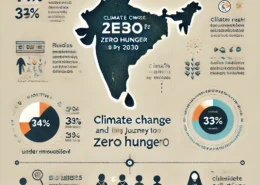Make a distinction between direct and indirect farm subsidies and explain the advantages and disadvantages of each.
Energy efficiency essentially means using a lesser amount of energy while producing a given amount of output. For example, incandescent lights used to transform only a maximum up to 10% of electrical energy to useful light, whereas LED light converts at least 25% of the energy input into visible ligRead more
Energy efficiency essentially means using a lesser amount of energy while producing a given amount of output. For example, incandescent lights used to transform only a maximum up to 10% of electrical energy to useful light, whereas LED light converts at least 25% of the energy input into visible light energy.
Need for promoting energy efficiency in India
- High demand for energy: A growing population and rising aspirations of a growing middle class is driving the demand for energy resources in India. One unit of energy saved at the consumption level reduces the need for fresh capacity creation by 2 times to 2.5 times.Therefore, energy efficiency plays a crucial role in ensuring energy access.
- Energy Security: India meets its energy demands majorly from oil and coal; 80% of which is imported. This necessitates saving energy for reducing import dependence that increases the vulnerability of the country’s economy to global geopolitical and economic risks.
- Cost considerations: High costs of electricity hinders the competitiveness of basic Indian industries in the global market. Energy efficiency measures are therefore not only important to save money on electricity bills but also improve ease of doing business.
- Environmental pollution: A focus on energy efficiency is also necessary to reduce the heavy pollution- especially air pollution- caused by the industry and transport sector.
- Combating climate change: Energy efficiency is central to achieve India’s Nationally Determined Contribution (NDC) targets to lower the emissions intensity of GDP by 33-35 per cent by 2030 from 2005 levels.
India had realised the importance of energy rationing long back, evident from the launch of the Energy Conservation Act in 2001. Overall, various energy efficiency measures have translated into savings worth INR 89,000 crores (approximately) in 2018-19 and contributed in reducing 151.74 Million Tonnes of CO2 emission in India. This has been made possible due to various government efforts such as:
- National Mission for Enhanced Energy Efficiency (NMEEE) under NAPCC: It aims to strengthen the market for energy efficiency by creating a conducive regulatory regime and fostering innovative business models. It includes market based mechanisms like Perform Achieve and Trade scheme, Energy Efficiency Financing Platform for raising finance etc.
- Promotion of Electric Vehicles National Electric Mobility Mission Plan (NEMMP): The government has launched the scheme namely Faster Adoption and Manufacturing of Hybrid & Electric Vehicles (FAME India) under NEMMP 2020 in the Union Budget for 2015-16.
- Capacity Building of DISCOMS: Ujwal DISCOM Assurance Yojana was launched in 2015 with the objective of capacity building of DISCOMs and promoting energy conservation programme.
- Promotion of Energy Efficient LED Bulbs – UJALA scheme: It aims to promote efficient use of energy at the residential level, enhance the awareness of consumers about the efficacy of using energy efficient appliances.
- Standards and Labeling: The Bureau of Energy Efficiency initiated the Standards and Labeling programme for equipment and appliances in 2006 to provide the consumer an informed choice about the energy savings.
By urgently and fully adopting an energy energy effici efficient lifestyle, India can build a positive momentum towards transformation of the energy system that will achieve the common climate change and sustainable development goals.
See less



Farm subsidies are a governmental subsidy paid to the farmers to supplement their incomes and enhance their farm productivity. In India, the overall farm subsidies amount to 2-2.25% of GDP. Further, agricultural subsidies can be categorized into direct and indirect farm subsidies. Direct Farm subsidRead more
Farm subsidies are a governmental subsidy paid to the farmers to supplement their incomes and enhance their farm productivity. In India, the overall farm subsidies amount to 2-2.25% of GDP. Further, agricultural subsidies can be categorized into direct and indirect farm subsidies.
While the agricultural sector in India is highly dependent on these subsidies, both these types of subsidies have their own merits and demerits.
Merits of direct farm subsidy
Demerits of direct farm subsidy
Merit of Indirect Farm subsidy
Demerits of indirect farm subsidy
Even though India’s agriculture sector is largely dependent on subsidies for sustainability, the government must look to rationalize the subsidies in a manner that it should not distort resource allocation and lead to over utilization of resources.
See less